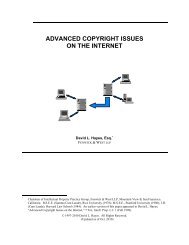International Tax Aspects of Foreign Currency Transactions
International Tax Aspects of Foreign Currency Transactions
International Tax Aspects of Foreign Currency Transactions
You also want an ePaper? Increase the reach of your titles
YUMPU automatically turns print PDFs into web optimized ePapers that Google loves.
Gain or loss is computed, without regard to 1.988-2(b)(8) (thenetting rule), as if the transferor QBU sold the units <strong>of</strong> property atFMV immediately before the transfer.(i)Example. X is a US dollar taxpayer with two branches, Yand Z, operating in the €. Y holds $25 in cash with a 20 €tax basis and 23 € fair market value. If Y transfers the $25<strong>of</strong> cash to X, this will cause Y to recognize 3 € <strong>of</strong> § 988gain under the branch transfer rule. The transfer also has§ 987 consequences as a transfer <strong>of</strong> property by Y to X.(ii) Example 2. Same, except that Y transfers the $25 to Z,which is also a € branch. In this case, since Z can step inthe shoes <strong>of</strong> Y, the branch transfer rule does not apply.The same rule can also apply to a transfer <strong>of</strong> a § 988 transactionfrom a foreign QBU to a U.S. QBU, or vice versa, because <strong>of</strong> thechange to the source <strong>of</strong> exchange gain or loss on the item.D. Timing <strong>of</strong> Recognition <strong>of</strong> <strong>Foreign</strong> Exchange Gain or Loss; Computing theAmount <strong>of</strong> <strong>Currency</strong> Gain or Loss from Section 988 <strong>Transactions</strong>.(1) General Principles. <strong>Foreign</strong> currency gain or loss is taken into accountwhen the § 988 transaction is settled or otherwise disposed <strong>of</strong> – i.e., whenthe taxpayer realizes and recognizes gain or loss on the overall transaction.See Treas. Regs. §§ 1.988-2(a) through (d). Typically, this occurs throughrealization events such as—(a)(b)(c)(d)Making or receiving paymentDisposing <strong>of</strong> units <strong>of</strong> non-functional currencySelling a loan receivable to another taxpayerTransferring property in settlement <strong>of</strong> a loan payableThis transaction-by-transaction, realization-based approach to computingexchange gain or loss contrasts sharply with GAAP’s mark-to-marketrules. At one time, the IRS considered allowing taxpayers to elect a bookconformity method that would mark-to-market all § 988 transactions (noless frequently than quarterly) consistent with financial accountingtreatment. See INTL-0015-91 (May 16, 1992), Prop. Reg. § 1.988-5(f).However, this proposal was not adopted. Perhaps the IRS and Treasuryquestioned their authority to extend mark-to-market accounting across theboard for § 988 transactions.12© 2013 William R. Skinner, Esq.Fenwick & West LLPwrskinner@fenwick.com
















